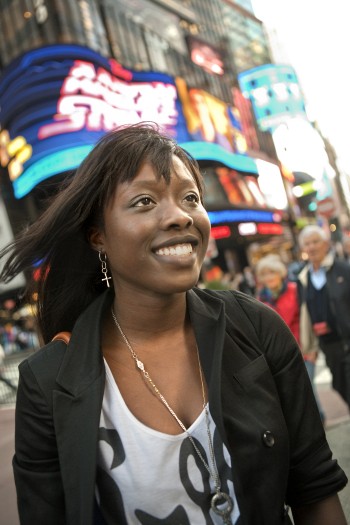COVER STORY

Students take on the Big Apple — Cornell's urban lab

Maria Teresa Asare-Boadi 11, a student in the Cornell Urban Semester Program, in the lights of Times Square across the street from the site of her internship at MTV Networks. See larger image
His laboratory equipment consists of a fat notebook and a stone park bench in East Harlem. Huicheng Zhong has logged many hours sitting here in the Dr. Ronald E. McNair Playground, watching everything and everyone, and writing down what he sees.
The children splashing in the fountain and running around on the patch of artificial turf (there is no real grass here) show no interest in the tall man from Guangzhou, a metropolis in southern China, and his stacks of charts and maps, but his work could one day change the way their playground looks.
A graduate student in landscape architecture at Cornell, Zhong has come to New York City to study how people interact with open space when there isn't much of it to spare.
He is preparing an analysis of how people use this park and 73 others in Harlem for the Manhattan Community Board 11, an independent city agency, and his internship sponsor last summer through Cornell's Urban Scholars Program. This kind of research helps the city design new parks and renovate old ones in ways that make sense. Zhong's data concentrate on revealing patterns created by people. "At the same time, the design of the park drives that pattern," he says. "There is a lot of potential for improvement."
New York City is the urban laboratory that makes Zhong's fieldwork possible. For him, as for the hundreds of Cornell students and faculty who can be found here at any given time, the city can be many things: A place to collaborate, an inspiration, an eye-opener -- and a necessity.
It is for all these reasons that Cornell maintains a vibrant, visible and growing presence in New York City.
A contrast in studies
Ithaca and New York City are 223 road miles from one another, but distance may be the least of what separates them. New York exists on a colossal scale. The population of Ithaca is 30,000 to New York's 8.3 million. Ithaca's TCAT bus system moves 3 million riders a year -- about the same number as the New York City subway system on a typical Saturday. Indeed, with 45,000 alumni living or working in the metro area, New York City even has more Cornellians than Ithaca itself, and many of them stay involved by enabling students to work and study as part of their organizations.
Today, Cornell capitalizes on the city's vastness and diversity to provide more opportunities for students than ever before, but its relationship with the Big Apple is a longstanding one.
Cornell has had students in New York City since at least 1898, the founding year of Weill Cornell Medical College (see related story, page 9). Although the medical school is still the conspicuous face of the university in the city and the nexus of scientific collaborations between researchers in Ithaca and Manhattan, a growing number of Cornellians can be found in all five boroughs, engaged in a remarkable number of disciplines.
"They just never end, our collaborations down in New York City," says Alan Mathios, the Rebecca Q. and James C. Morgan Dean of the College of Human Ecology. "New York City provides a natural learning-living environment that is relevant to a significant portion of the research, education and outreach mission of the college and university.